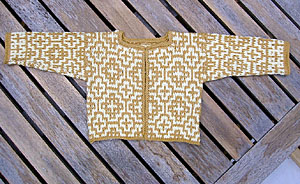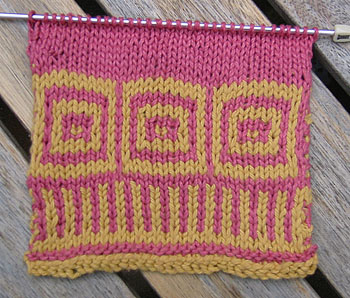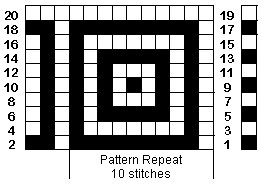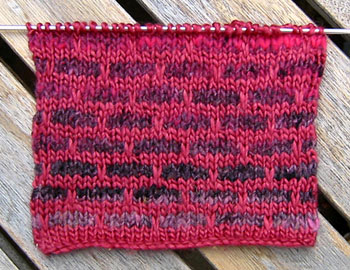
 If
you've stuck to knitting in single colors,
or maybe just ventured into stripes, here's
some good news: You can achieve what appear
to be complicated color patterns while using
only one yarn at a time! Many knitters suffer
from fear of Fair Isle because they are loathe
to carry two colors at once. It seems complicated
and unwieldy. If you're ready for a little
more adventurous use of color and pattern,
why not try mosaic knitting? Using a simple
slip-stitch technique, you can create bands
and borders in pattern, or even a whole sweater,
and you won't ever have to carry a second
yarn along!
If
you've stuck to knitting in single colors,
or maybe just ventured into stripes, here's
some good news: You can achieve what appear
to be complicated color patterns while using
only one yarn at a time! Many knitters suffer
from fear of Fair Isle because they are loathe
to carry two colors at once. It seems complicated
and unwieldy. If you're ready for a little
more adventurous use of color and pattern,
why not try mosaic knitting? Using a simple
slip-stitch technique, you can create bands
and borders in pattern, or even a whole sweater,
and you won't ever have to carry a second
yarn along!
Color slip-stitch knitting
has been around for a long time, but it was
brought into the spotlight for a time by Barbara
Walker who dubbed the style "mosaic knitting"
in the late '60s. Hundreds of mosaic patterns
appear in Walker's books. More recently, Roxana
Bartlett has taken a new look at this approach
to color patterning. If you become smitten
with this technique after trying it, you can
find more information and patterns in their
books. [See "Recommended Reading"
below.]
The technique of two-color
slip-stitch knitting is really quite simple:
If you can knit simple stripes and slip a
stitch, you have all the skills you need.
Mosaic knitting simply involves slipping the
stitches in a row that should be the "other"
color. If you are knitting the dark color,
you slip the light; if you are knitting the
light color, you slip the dark.
Aside from the allure of
color patterning using just one yarn at a
time, slip-stitching has other advantages
over other multicolor techniques: Mosaic knitting
works well either flat or in the round which
gives it more flexibility than intarsia or
Fair Isle techniques. It also doesn't leave
as many floats as Fair Isle knitting, so the
fabric is not as heavy and not as much yarn
is used.
There are a few limitations
to the technique. Because stitches are slipped,
there's a limit to how many stitches of the
"wrong" color you can work consecutively
-- two or three, depending on who you talk
to. This tends to give the patterns created
a geometric look, which may have reminded
Barbara Walker of tile mosaics. Also, the
slipped stitches make the fabric a little
less than smooth, but blocking will usually
take care of this. For this reason, yarns
with a little more "give" tend to
work better, though the toddler sweater above
is knit in pure cotton. If you knit very tightly,
you may want to go up a needle size so that
your stitches can be slipped two rows without
puckering.
I find slip-stitch knitting
to be a great introduction to color patterning.
There are bits of "Pay attention; read
the chart!" combined with the auto-pilot
knitting of every other row. And once you
get the feel of a certain motif, you will
be able to see it in your knitting without
the chart.


READING the chart

Usually mosaic patterns
are charted; most are not very large [maybe
20 stitches wide], but there is really no
limit. The charts usually have a color bar
on the right side indicating which color is
being worked for each row. The chart has the
rows numbered, odd numbered rows on the right,
even numbered rows on the left. The second
row worked in a color is always worked exactly
the same as the first: if a stitch was knitted
in the odd row, it is worked in the even row;
if a stitch was slipped in the odd row, it
is slipped again.


 Sometimes,
particularly for simpler motifs such as the
brick pattern at right, directions are written
out like standard knitting patterns.
Sometimes,
particularly for simpler motifs such as the
brick pattern at right, directions are written
out like standard knitting patterns.
MC: CO a multiple of 6 sts
-1.
Row 1: Knit.
Row 2: Purl.
Row 3: CC: *K5, sl1* end
k5.
Row 4: *P5, sl1* end p5
Repeat these 4 rows as until
desired length is reached.

Getting started
After choosing a mosaic
pattern [or patterns] you like, you can easily
map it on to any garment. While you want to
repeat the entire motif to see the whole pattern,
you need not necessarily have a number of
stitches that is an exact mulitple of the
number of stitches in the motif. You may cut
a motif off in the middle without making a
mess. With any project, you will want to work
the selvedge stitches in the row's color.
Never slip the selvedge stitch. This will
keep your pieces smooth and easy to join together.
After casting on, work two
rows in the first color [say, the lighter
color], then attach the second color, leaving
the first hanging. With the darker yarn, the
light-colored stitches shown on the chart
are slipped and the darker stitches are worked.
Always slip stitches as if to purl; that is,
insert the needle from right to left, and
carry the yarn on the wrong side of the work.
After you have knit your second row with the
darker color, switch back to the light. You
will always work two rows in each color and
the two rows are the same: a stitch never
changes its color in the second row. Continue
working your way up the chart until you complete
the motif.
After you have finished
with one motif, you may repeat it again, either
the same way, or by trading light and dark
colors; switch to a second motif, or carry
on with plain knitting. A mosaic border on
cuffs and hem will add punch to an otherwise
plain sweater, or try working a stripe of
a larger motif across the chest of a sweater.
And though I have described these techniques
as two-color, that is certainly not the limit
of this technique. You can keep one color
constant and alternate the second. Or try
one plain yarn and one variegated yarn. Using
a plain colored yarn and one space-dyed yarn
can yield very impressive multicolor results
- all just one strand at a time.
Bartlett, Roxana.
Slip-Stitch
Knitting.
Interweave Press, 1998.
Walker,
Barbara. Charted
Knitting Designs. Charles Scribner &
Sons, 1972.
Walker,
Barbara. Mosaic
Knitting.
Encore Editions, 1976.
Walker, Barbara. A
Second Treasury of Knitting Patterns.
Charles Scribner & Sons, 1970.

